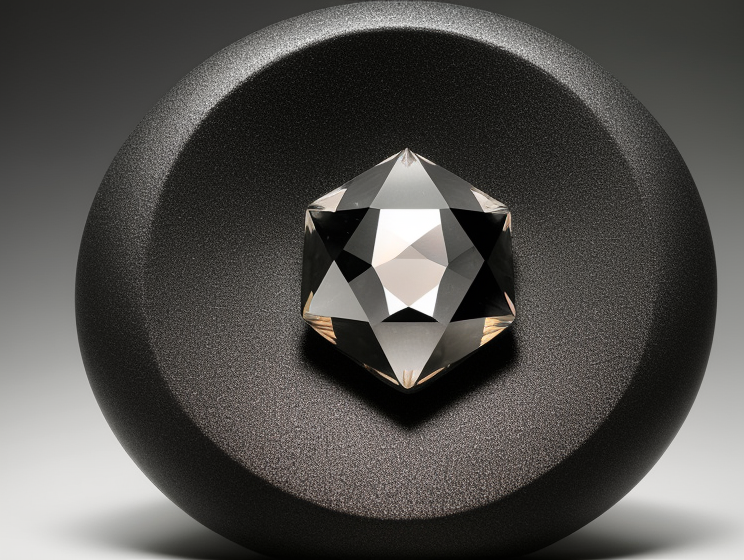
Jewelry Made from Ashes
Jake FoxShare
Cremation Diamonds
Based on extensive research and industry experience, it is our professional opinion that the creation of diamonds using the ashes of loved ones is often grossly misunderstood, and in some cases may even be deceptive and misleading.
What is a Cremation Diamond?
Cremation diamonds are a type of lab grown diamond. There are currently two processes by which lab grown diamonds are produced, HPHT and CVD. Cremation diamonds use the HPHT process, with the only difference between a cremation diamond and any other HPHT lab grown diamond being the origin of a percentage of the materials used during the creation process.
At the time of this writing, all lab grown diamonds require a natural diamond seed. This "seed" refers to a very small natural diamond crystal. The HPHT method was developed in the 1950s, and stands for "high pressure, high temperature", which is the means used to turn this small natural seed into a larger lab grown crystal.
The natural diamond crystal put in an extremely pressurized environment and subjected to temperatures over 5000 degrees Fahrenheit, all while being bombarded with carbon atoms. As these atoms merge, they form a rough diamond crystal. It generally takes about two weeks to form a crystal capable of producing a one carat diamond. Once this is complete, that rough diamond goes through the same cutting and polishing process as any mined diamond, cutting away around 50% of the mass to end up with an attractive faceted gem.
The idea is that what makes cremation diamonds different is that the carbon used in the process comes from the ashes of a loved one; but that's where things get a lot more complicated.
Your Carbon Footprint
During cremation, all organic matter is consumed or evaporated. This process begins at around 400 degrees Fahrenheit, while most cremation chambers reach temperatures of 1600 to 1800 F.
Cremation erases all DNA, all organic matter, and most carbon. Studies have shown that a very small percentage of carbon can remain in bone fragments. It is generally agreed that around 0.5 - 4% of cremains may be carbon.
The obvious question is whether or not this is enough to create a diamond, and the answer is vague and inconsistent. The carbon found in cremains may or may not be enough to create a diamond. Additional carbon is often added to complete the process. This is sometimes through hair or other sources that you can provide, or it may be from an outside source. If you provide 100% of the necessary carbon, then in theory the resulting diamond could be made up of just your carbon and the natural seed, but actually knowing how much of the resulting gem is formed from carbon you provide is impossible.
There is no way whatsoever to determine what percentage of the complete diamond was derived from the ashes you supplied.
In the eyes of modern testing equipment, carbon is carbon. As stated above, there is no DNA or other personal marker. This means it is basically impossible to verify any sort of claim as to what percentage of your diamond is or is not from carbon you provide.
Even if you fully trust the process, and if you fully trust the company performing the grow: The cremation diamond could, in theory, still only have a very small percentage of the carbon you provided in its total makeup. There is no way to quantify it, and no way to know for sure.
There is one more factor that is almost never discussed.
Carbon Is Forever
Carbon exists on Earth in three isotopes. Two of these, C-12 and C-13, are stable. They are as old as the planet we live on, in fact, most scientists would argue they are older than that, and because they are stable they will exist forever.
We get carbon from a number of different sources, and we also lose carbon in a number of ways. The most common of these is breathing - a process by which we humans exhale carbon thousands of times a day in the form of CO2.
If you remember learning about the carbon cycle in school, we're all part of that. The carbon in our bodies isn't specifically ours, it is recycled millions of times over.
The carbon that is recovered from ashes comes from bones, which is calcium carbonate. Although you may think of your bones as unchanging, they are actually reforming daily, and this process involves the expulsion and recycling of carbon as well. The carbon in your bones may not have actually been part of you for very long.
Most of the carbon in the human body is C-12 and C-13, which means that the atoms in us have also been in millions of other living creatures since the dawn of time. Not only that, but the carbon in your body today may not be the carbon in your body tomorrow. Some can stay with you for the majority of your life, while some is breathed out after only a few seconds.
Carbon contains no DNA, and is in no way specific to any one person. It is something that we need in order to exist, but my carbon is in no way uniquely my own. Even within my lifetime, my carbon has been part of someone else, and it will be part of someone else.
The carbon found in cremains may have been a part of that person's body for a moment in time, but it almost certainly was not for a lifetime. All organic matter, including DNA, is destroyed at temperatures much lower than those found in a modern crematorium, and exponentially lower than those used in the HPHT process.
Our Verdict
None of this means that every company offering to turn your loved one's ashes into diamonds is being dishonest. If they are following every step of the process carefully and properly, then they may very well be delivering diamonds created with some percentage of carbon that you supplied.
However, the facts speak for themselves:
- Carbon is not unique to an individual person
- It is unlikely if not impossible that a cremation diamond can be made 100% from your supplied carbon
- There is no way to determine what percentage originated where
For our part, we choose not to deal with cremation diamonds in any way. We feel the product is widely misunderstood, difficult to justify, and impossible to verify. We respect our customers' right to decide for themselves, but we will never ask for your hard eared money in return for a product in which we are not confident.
Alternatives
It is our opinion that there are better, and more meaningful ways to honor the memories of our loved ones. These can range from wearable urns and Victorian-inspired mourning jewelry, to pieces made to celebrate the lives of the deceased.
Carbon is not unique to one person, but memories are. One of the greatest elements of true custom jewelry is the ability to incorporate these memories in unique ways! Over the years, we have made pieces that used gold and diamonds from heirloom wedding sets, wood from the first home they built together, and even a piece of the literal ground where a couple met!

In addition to utilizing sentimental objects and materials, we can also create pieces that represent certain people or activities by telling their stories. We have made pieces with fingerprints, paw prints, handwriting, and even portraits.
Don't settle for less than the best.
Let us help you tell your story the right way.
